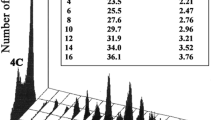Abstract
By means of β-merkaptoethanol a distinct increase of endoreduplications in blood cultures of human origin can be produced. Such merkaptoethanol-induced endoreduplications were the object of morphological research and experiments concerning the pattern of DNA-synthesis.
Merkaptoethanol-induced endoreduplications are to a high degree similar to spontaneous endoreduplications both in morphology and function. In the chromosomes formed into pairs in endoreduplication (socalled diplochromosomes) morphologically distinguishing marks are always equally developed (e.g. secondary constrictions, division of the centromere). Even twists of the chromatids within a chromosome are to be found in a like manner in the other partner of the diplochromosome.
Endoreduplication consists of two successive DNA-replications without mitosis between.
If H3-thymidin is incorporated during the first DNA-replication the respective chromatids of the diplochromosome lying at the outside are labelled in metaphase whereas all the chromatids of the diplochromosomes are labelled, if H3-thymidin is incorporated during the second reduplication.
The “lying outside” of the labelled chromatids allows the conclusion that (1) there is a regular distribution of half-chromatids during the DNA-replication. In addition to that the must be (2) a difference concerning the affinity between certain chromatids, which causes the single chromosomes of diplochromosomes to lie in a certain order to each other during the preparation of the chromosomes.
A knowledge of these relations may be useful to set up a model of the chromosome.
Zusammenfassung
An durch β-Merkaptoäthanol induzierten Endoreduplikationen in Blutkulturen wurden morphologische und autoradiographische Untersuchungen angestellt. Merkaptoäthanolinduzierte Endoreduplikationen gleichen sowhl in morphologischer als auch funktioneller Hinsicht weitgehend spontan auftretenden Endoreduplikationen. Auf das identische Verhalten der Chromosomen des einzelnen Diplochromosoms in verschiedenen Eigenschaften (Zentromer, sekundäre Konstriktionen, Verdrehungen der Chromatiden) wird besonders hingewiesen. Die Endoreduplikation besteht aus zwei aufeinanderfolgenden DNS-Synthesen ohne Kernteilung dazwischen. Wird in der ersten Synthese H3-Thymidin eingebaut, so finden sich in der späteren Metaphase jeweils die “außen” gelegenen Chromatiden des Diplochromosoms matkiert. Dieses Verhalten und seine Bedeutung für das Verständnis der Chromosomenreplikation wird diskutiert.
Similar content being viewed by others
Literatur
Beermann, W., u. C. Pelling: H3-thymidin-Markierung einzelner Chromatiden in Riesenchromosmen. Chromosoma (Berl.). 16, 1–21 (1965).
Bender, M. A., and D. M. Prescott: DNA synthesis and mitosis in cultures of human peripheral leucocytes. Exp. Cell Res. 27, 221–229 (1962).
Fraccaro, M., K. Kaijser, and J. Lindsten: Somatic chromosome complement in continously cultured cells of two individuals with gonadal dysgenesis. Ann. hum. Genet. 24, 45–61 (1960).
Geitler, L.: Die Entstehung der polyploiden Somakerne der Heteropteren durch Chromosomenteilung ohne Kernteilung. Chromosoma (Berl.) 1, 1–22 (1939).
—: Endomitose und endomitotische Polyploidisierung. Protoplasmatologia, VI/C., Wien: Springer 1953.
Hsu, T. C., and P. S. Moorhead: Chromosome anomalies in human neoplasms with special reference to the mechanisms of polyploidization and aneuploidization in the HeLa strain. Ann. N.Y. Acad. Sci. 63, 1083–1095 (1956).
Jackson, J. F.: Polyploidy and endoreduplication in human leucocyte cultures treated with β-Mercaptoethanol. Exp. Cell Res. 31, 194–198 (1963).
— and D. Killander: DNA synthesis in Phytohaemagglutinin-stimulated human leucocyte cultures treated with β-Mercaptoethanol. Exp. Cell Res. 33, 459–467 (1964).
— and K. Lindahl-Kiessling: Action of sulfhydryl compounds on human leucocyte mitosis in vitro. Exp. Cell Res. 34, 515–524 (1964).
Levan, A., and T. S. Hauschka: Endomitotic reduplication mechanisms in ascites tumors of the mouse. J. nat. Cancer Inst. 14, 1–43 (1953).
— and T. C. Hsu: Repeated endoreduplication in a mouse cell. Hereditas (Lund) 47, 69–71 (1961).
Mazia, D., P. J. Harris, and T. Bibring: The multiplicity of the mitotic centers and the time course of their duplication and separation. J. biophys. biochem. Cytol. 7, 1–20 (1960).
Moorhead, P. S., P. C. Nowell, W. J. Mellman, D. M. Batipps, and D. A. Hungerford: Chromosome preparations of leucocytes cultured from human peripheral blood. Exp. Cell Res. 20, 613–616 (1960).
Prescott, D. M., and M. A. Bender: Autoradiographic study of chromatid distribution of labeled DNA in two types of mammalian cells in vitro. Exp. Cell Res. 29, 430–442 (1963).
Schrader, F. and S. Hughes-Schrader: Chromatid autonomy in Banasa (Hemiptera: Petatomidae). Chromosoma (Berl.) 9, 193–215 (1958).
Schwarzacher, H. G., and W. Schndedl: Endoreduplication in human fibroblast cultures. Cytogenetics 4, 1–18 (1965).
—: Position of labeled chromatids in diplochromosomes of endo-reduplicated cells after uptake of tritiated thymidine. Nature (Lond.) 209, 107–108 (1966).
Taylor, J. H.: Sister chromatid exchanges in tritium-labeled chromosomes. Genetics 43, 515–529 (1958).
—: The replication and organization of DNA in chromosomes. Molecular Genetics, Vol. 1, p. 65–111. Edit.: J. H. Taylor, New York: Academic Press 1963.
Walen, K. H.: Spatial relationships in the replication of chromosomal DNA. Genetics 51, 915–929 (1965).
Author information
Authors and Affiliations
Rights and permissions
About this article
Cite this article
Schnedl, W. Geregelte Anordnung der Chromatiduntereinheiten in den Diplochromosomen bei der Endoreduplikation. Hum Genet 4, 140–152 (1967). https://doi.org/10.1007/BF00291259
Received:
Issue Date:
DOI: https://doi.org/10.1007/BF00291259




